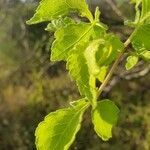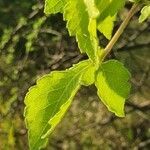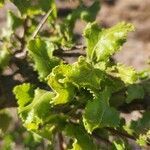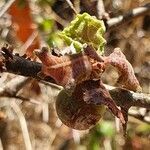Dioecious many-stemmed shrub usually less than 1 m tall or small tree with a single trunk up to 4 m tall; bark grey or greyish green, occasionally flaking locally in small yellowish papery pieces; young branchlets pilose to tomentose, mostly spine-tipped. Leaves trifoliolate, pilose to tomentose, green; petiole 2-35 mm long; leaflets broadly obovate or broadly elliptic, sessile or subsessile, margin coarsely crenate or crenate-serrate, apex obtuse to acute, base cuneate or truncate, terminal leaflet (8-)18(-65) x (6-)13(-50) mm, lateral leaflets (4-)8(-35) x (3-)7(-30) mm. Inflorescence: flowers borne in clusters. Flowers unisexual, hypogynous, glabrous. Pedicel 1.0-2.5 mm long. Disc 4-lobed, not adnate to perianth. Stamens 8. Fruit subglobose, ±15 x 12 x 12 mm, glabrous; putamen very rugose; pseudo-aril red, with 4 arms of variable size and form, often also isolated fragments, 2 commissural arms reaching almost to apex of putamen, 2 facial arms of variable length.
A shrub or small tree. It grows 2-5 m high. It has many branches and is spiny. The trunk is grey and the bark does not peel. The young branches are densely hairy and with spines at the tip. The leaves are on long hairy stalks. The leaves are made up of 3-5 leaflets. These are usually hairy and have rounded teeth along the edge. The leaflet at the end has a narrow base and blunt point. It is the largest leaflet. The flowers are red and in short clusters in the axils of leaves. The flowers are produced before the leaves appear. The fruit are small and round. In fresh fruit the layer around the seed is red.
Leaves 3-foliolate; petiole up to 4·5 cm. long, but usually less, pubescent or pilose; terminal leaflet up to 8 × 5 cm., often smaller, obovate, apex acute or obtuse, base gradually cuneate, lateral leaflets about 1/2–3/4 the size of the terminal one, elliptic to rotund, apex acute or rounded, margins (of all leaflets) coarsely crenate or crenate-serrate, base rounded or broadly cuneate, both surfaces pubescent or occasionally glabrous above.
Fruit c. 1·2 cm. in diam., subglobose; pseudaril apparently absent or occasionally irregularly lobulate and covering about 3/4 of the endocarp; endocarp c. 1 cm. in diam., subglobose but with one face more nearly hemispherical than the other, rugose, the two faces separated by a narrow wing-like rim.
Shrub or small tree c. 2–5 m. tall; bark smooth, dark green or yellowish, peeling in yellowish strips; young branches densely pubescent or tomentose with short whitish hairs or sometimes yellowish longer hairs, spiny.
Many-stemmed shrub or small tree, up to 4 m high. Branchlets spine-tipped, pilose to tomentose. Leaves 3-foliolate; leaflets pilose to tomentose, broadly obovate or elliptic. Fruit subglobose.
Flowers appearing before the leaves in axillary abbreviated clusters, often borne on the spines; pedicels up to 2 mm. long, pubescent or glabrous.
Petals 3–5 mm. long, stamen-filaments subterete, slender above but broadening somewhat near the base.
Calyx c. 2 mm. long, campanulate, lobed to about 1/3-way, glabrous or pubescent.
A shrub or small tree up to 20 ft. high, usually with spines
Flowers reddish, usually produced when leafless
Disk-lobes 4, ± bifid at the apex.
Bark of branchlets reddish purple
Leaves and bark fragrant-resinous





